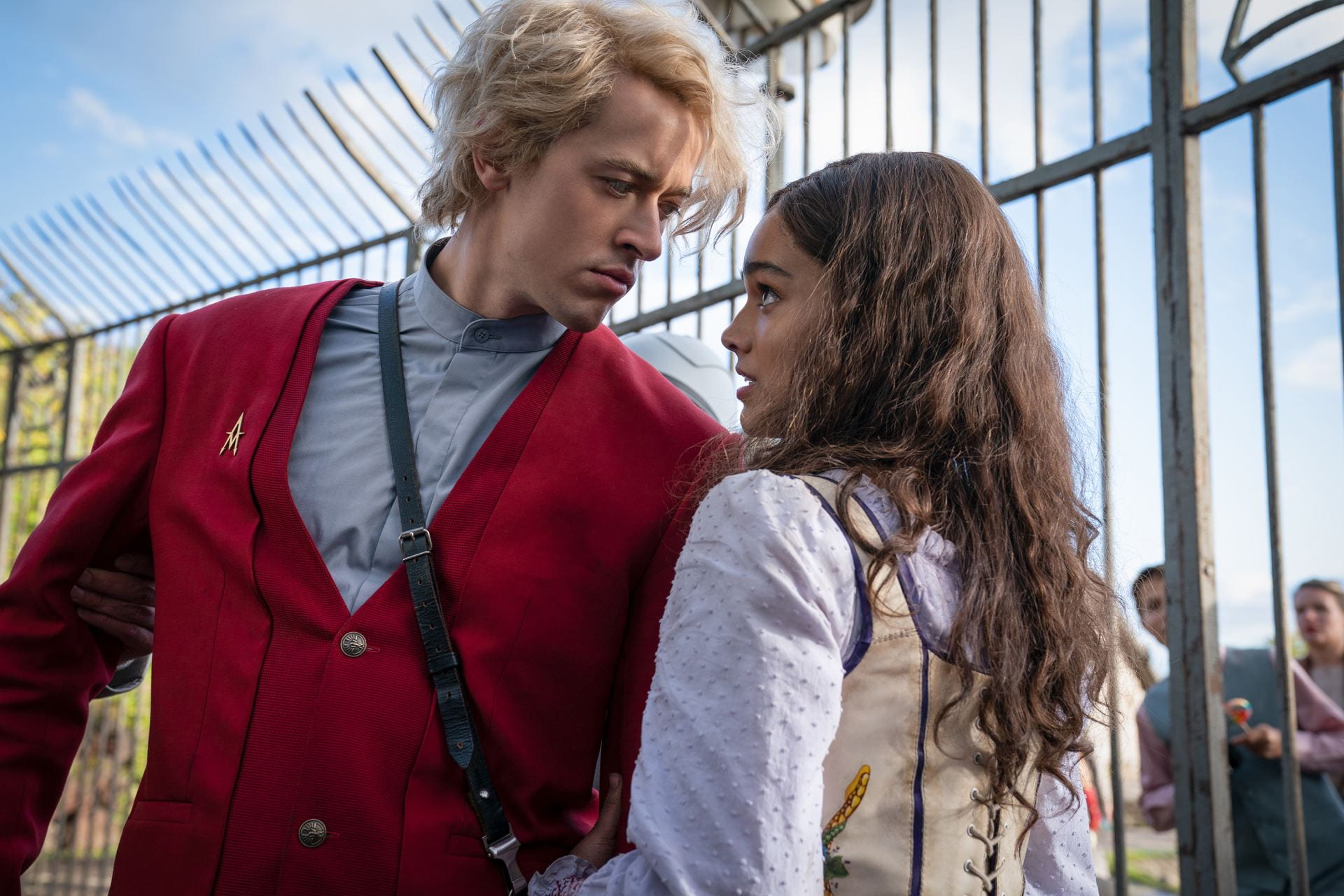
Tom Blyth, left, and Rachel Zegler in “The Hunger Games: The Ballad of Songbirds & Snakes.” (Murray Close/Lionsgate/TNS)
For anyone even the slightest bit in tune with 2010s pop culture, “The Hunger Games” was an inescapable franchise.
After the first book was published in 2008, Suzanne Collins’ novel trilogy caught fire and ignited four equally popular movies across the decade. Notably, the first film adaptation featured a breakout performance from actress Jennifer Lawrence, whose rising popularity mirrored that of her fictional counterpart, Katniss Everdeen.
Now, in 2023, “The Hunger Games” has reinvigorated its legions of fans for another trip to the theater.
Based on Collins’ 2020 novel of the same name, “The Hunger Games: The Ballad of Songbirds and Snakes” is set 64 years before the original series’ events. It follows a young Coriolanus Snow (Tom Blyth) in his simultaneous descent into madness and rise to power as he journeys to become president of Panem, a dystopian society that holds an annual “Hunger Games” in which adolescents from 12 separate districts must fight to the death until one victor remains.
The film is split into three parts spanning different notable points in Snow’s life, centering around his relationship with Lucy Gray Baird (Rachel Zegler), a 10th annual Hunger Games tribute he must mentor so as to prove his competence to the country’s elite.
“The Ballad of Songbirds and Snakes” is the first major role for actor Blyth in a blockbuster and his performance rivals that of Lawrence a decade earlier.
The film serves as a character study of “The Hunger Games” franchise’s primary villain, meaning it requires a masterful performance from its lead actor to be successful. Blyth does not disappoint. He will surely be a hot commodity for future Hollywood projects.
But Blyth doesn’t deliver the movie’s only stirring performance. It’s impossible to have a film with Peter Dinklage (“Game of Thrones,” “Elf”) in which he doesn’t steal every scene he’s in, and it’s no different in “The Ballad of Songbirds and Snakes.”
Dinklage plays Casca Highbottom, dean of the prestigious academy Snow attends as well as the Hunger Games’ creator. His exposure to a broad range of roles complements the performances from the younger actors and actresses.
Jason Schwartzman, best known for his numerous roles in Wes Anderson projects, provides some witty humor as Hunger Games host Lucky Flickerman, although his quips sometimes break emotional scenes’ building tension and partially damage the audience’s immersion.
Part of this serves to emphasize the way tragic circumstances shown on screen are twisted for mindless entertainment within Panem; but at the same time, the film would have benefited from picking its moments to let the pithy remarks slide more carefully.
Hunter Schafer (“Euphoria”) is perhaps the most interesting character in every scene she appears in — depicting Snow’s once-beloved cousin Tigris — but she unfortunately isn’t given the time she deserves to truly shine.
When it comes to Rachel Zegler’s performance as Baird, her character never seems to find her exact place in the story.
Baird is known for being the singer of a traveling band, and when viewers are introduced to her at the Reaping — a ceremony at which the tributes are selected to play in the game — she breaks into song.
Zegler has a powerful voice, and while filmgoers become more accustomed to musical interjections as the narrative progresses, the first time Baird sings is so abrupt it’s almost laughable. It’s a shame because the character’s musical talent could have been situated more comfortably within the plot if it had not been displayed so early on.
Additionally, Baird is no Everdeen, and she isn’t supposed to be; that being said, the movie lacks the presence and defiance of the original series’ female lead, which was a main contributor to its success.
One of the most commendable achievements of “The Ballad of Songbirds and Snakes” is that audiences will likely never feel bored throughout its near-three-hour runtime.
Even so, the film falls into a rare trap: it would actually work better as two films, or possibly a TV series. It’s trying to build upon an expansive world and tell such a rich story that it naturally sacrifices some depth at the expense of fitting a time limit.
The plot also takes a drastic turn in the movie’s third act, as the games wrap up and Snow is banished to the same district where Baird resides, almost making it feel like a completely different film. It’s just as entertaining in its own way, but the sudden and distinct jump away from the games results in the entire section feeling somewhat rushed.
But these faults in the story are overshadowed by the delight of following Snow as he cunningly spins a web of deceit and manipulates his way to the top.
The film is relentlessly tense, reminiscent of the heart-racing nature of the games themselves. It breaks the boundary of the screen and makes the audience feel like they’re right there in Panem, finding guilty pleasure in the adrenaline of the massacre in front of them.
“The Ballad of Songbirds and Snakes” is a masterclass in production design, with intricate sets, wardrobe and top-class filmmaking. The trade-off of this sleekness is that some of the 2000s camp and aesthetics that were factors to the original movies’ success are lost, though that may just be a victim of the times that must be accepted.
Maybe the film’s most significant aspect is that it adds more depth to the main series, advocating for a total rewatch and reigniting the passion fans had for the “Hunger Games” world a decade ago.
Overall, “The Ballad of Songbirds and Snakes” sings an alluring melody that will captivate audiences, regardless of their preexisting levels of devotion to the franchise.
Rating: 4/5


